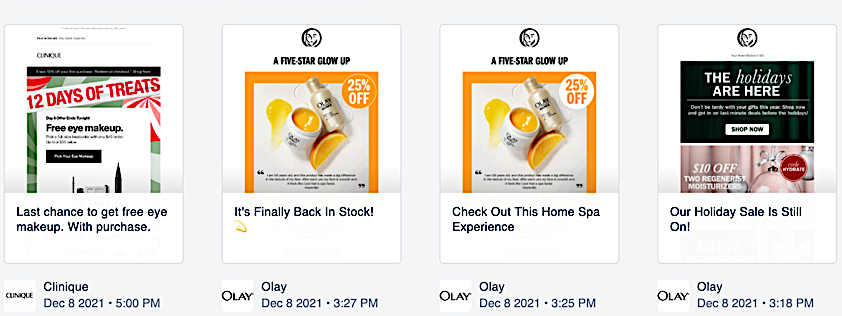Getting the subject line right can be one of the hardest parts of creating a successful email campaign. Google “subject line help” and you’ll get about 10 billion search results. (You’ve probably done this, so you know we aren’t exaggerating.)
You can even buy software that claims to write the best subject lines for you automatically. But a better way for ecommerce email marketers on tight deadlines to write compelling, open-me-now subject lines is to start from a stronger place.
Forget all the advice you read about the 10 best subject lines for ecommerce email. Those might work for some ecommerce markets, but probably not for yours.
In this post, we’ll use MailCharts data to show how you and your email marketing team can develop strategies for researching, writing, and testing subject line formats and copy styles that consistently drive more opens, clicks, and conversions for your unique customers.
The goal: not reinventing the wheel every time you face that blank subject line field in your email composer. What you know about your customers and what you discover leading ecommerce brands are doing to connect with their audiences will help you come up with strategies to make writing subject lines faster.
But what if you need some fast subject line inspiration now for a campaign that’s launching tomorrow? We can help with that too.
Why subject lines still matter
They’re your customers’ first contact with your brand, and they work hand in hand with the sender line (who sent the message) and the preheader (the first line of text in the email message) to persuade subscribers to stop scrolling and open the email right then and there.
Seems simple enough, but it gets complicated fast. Does your subject line stand out in the inbox? Does it reward the person who opens the message, or will people feel as if they have been clickbaited into opening? Is it long enough to convey the key point of your email, yet short enough to deliver its punch before getting cut off?
Start with the data
Look back at the engagement metrics on your most successful campaigns over the previous quarter or year. You can start with campaigns with the highest open rates. However, opens are not a reliable engagement metric because they can both over-and under-report the true number of email opens.
Also, look at the campaigns that had the highest clicks, conversions, revenue per email, order value, or other results-focused metrics. See if you can find any patterns that work. You’ll probably come up with several that work on different kinds of campaigns.
Don’t worry if you don’t find a consistent pattern. That’s one big problem with writing subject lines—there’s no “easy” button for writing them.
Your next steps are to discover what other brands like yours are doing with subject lines. Then, test different formats to look for winning combinations.
Best practices: Let’s go to the emails!
To illustrate these points, we’re using the Beauty and Personal Care industry group in the MailCharts Index, a curated group of 171 brands. This group contains household names and newcomers that are doing cool things with email—like writing inventive and captivating subject lines. Not a MailCharts user yet? Create a free account in minutes so you can discover even more great subject line inspiration.
Align subject line calls to action with email copy: You can’t go wrong if you use the subject line to tell your customers what they’ll get by opening your email. The example email below from Clinique illustrates this perfectly. In just a few well-chosen words, the subject line explains both the benefit (the freebie) and the fine print (it comes with a purchase).
What you’re seeing is exactly how our email examples show up in MailCharts, with the subject line first and then the message itself. Look at how the email copy replicates the subject line in bold type—a bonus that helps your time-pressed customers see the benefit right away instead of trying to figure it out for themselves.

This tactic works best when you want shoppers to jump on your offers right away instead of thinking them over.
This email from This Works takes a different approach.

The subject line “Are you looking after yourself?” stands out in an inbox full of urgency-driven discounts and can make the customer pause scrolling long enough to see what the email is all about. The top copy block pays off the subject line immediately before moving into product promotions.
(There’s a lot to love in this email, especially about positioning product benefits in ways customers would relate to. If you’re curious, click to see the whole email.)
Remember the sender line and preheader: The subject line does the heavy lifting in the inbox, but the sender line and preheader give subscribers even more reasons to open the email.
There are a few hard-and-fast rules in email marketing, but here’s one of them: Never display an email address in the sender line. Always use a brand name that your customers would expect to find. Email addresses in the sender line look spammy, especially if it’s the default “[email protected].”
This image from the inbox view (toggle between viewing thumbnails of email images or the inbox view) shows three brands that use all three fields to create an attention-getting inbox presence. The subject line is in boldface, and the preheader follows in lightface.

Most email clients will pull the top line of the email copy into the preheader box for users who enable preheaders. Your email composer might give you the option to create a unique preheader. If not, make sure the first line of your copy has this value-added statement instead of a do-nothing statement like “Click here to view this email online.”
Remember the emojis! Emojis can add a little extra spice to your subject lines and add little pops of color that can make them stand out—unless you’re using the same emojis as everyone else.
The present emoji is everywhere around gift-giving holidays. Experiment with other emojis to pique a subscriber’s curiosity. We love how Beauty Bay uses the “no way” emoji to ramp up the intensity of its “No salon needed” subject line.

This weightlifter on a NYX email got our attention:

Can you go overboard on emojis? Sure, if they don’t have anything to do with your subject line or email copy. Pick emojis that are easy to view on mobile screens and follow standard protocols. If you use a nonstandard emoji, the email client might not render it and your subscriber will see only a big X or ?.
Test and test again: Subject line testing is just about the easiest testing to set up, especially if you are using A/B testing, which pits one variable against another. Many email platforms have this built in as a standard feature.
Testing is important because you can use it to find the subject line version that should deliver the best results. The key is to choose the right metric. If you want to drive sales, the version that got the most opens might not generate the most clicks.
If you’re running an A/B test, your next step will be to create two distinct variables. A little strategic thinking can help you create versions that will produce meaningful differences. Instead of just tweaking a word or two, choose subject line variables with varying approaches.
You could write a control subject line that focuses on the offer itself and then create a test version that plays on emotion, such as fear of missing out.
Another scenario: Subject Line A highlights the product benefit (“No more chapped winter hands”), while the B version leads with the promotion.
Look at the two versions of the same email Olay sent. Because the copy is the same, we can conclude that Olay is testing subject lines. One subject line plays on the back-in-stock theme while the other highlights what customers can expect with the featured product:

Personalize with more than a name: First-name personalization is a start, but it has become so commonplace it doesn’t really compel viewers to open an email the way it did back when personalization was the latest tactic.
What gets someone’s attention? Data that shows you know who they are. If you have loyalty data, such as a points balance or tier level, add it to the subject line to get the attention you need to drive an open.
On some email platforms, it’s easier to merge customer data in the message itself. If that’s the case for you, personalize the first line of your email message with that data so it shows up in the preheader, like this one from Estée Lauder:

Find subject line inspiration fast
Scrolling through email after email in your inbox can often feel more like doomscrolling, and who has time for that? Use the filters on MailCharts’ customizable search fields to find results fast.
You’ll discover handy prompts for your own subject line writing or ideas for testing character counts, images, copy, personalization, CTAs, and emojis—in other words, everything we covered here.
Make 20 percent off look exciting: Visit the emails section of MailCharts’ Beauty and Personal Care industry page to bring up the 215,000+ emails in the group’s database. Next, click on the blue Filters button and choose your search filters.
We chose four as an example:
- Emails in the last three months
- Discounts from 10 percent to 25 percent
- Optimal character counts (around 60 including spaces)
- Animated GIFs in the message body, just for fun
That gave us 1,500 emails to review. Here’s what our search with filters looks like in the MailCharts app:

We found a potential winner after scanning just 20 thumbnails: “🎁 Enjoy your new fave offer with 25% off gifts*… 🎁 from The Body Shop. If we had time to test an alternate, we’d go with something like this benefit-focused subject line from Bobbi Brown Cosmetics: “Holiday travel? Glow with these.” If we wanted to test whether longer or shorter subject lines delivered more clicks or conversions, we would consider “Worth it” from Nars.
Total time invested from search to discovery: 11 minutes, 104 emails scanned.
Get more intel in your subject line search: Subject line reports can tell you much more about the copy and tactics your discovery brands are using:
- Popular terms tell you which words are trending with brands in your industry group. Use this information to market against other brands so you can stand out.
- Significant terms highlight unusual combinations that often reveal product trends. If you want to find out why “Moisture” was trending in the Beauty and Personal Care group, click the link that takes you to the 124 emails that use that term.
- Subject line length: This statistic tracks trends in the number of characters brands use in their subject lines. Shorter subject lines are more likely to deliver all of their information before the inbox cuts them off. But longer subject lines can lead to more conversions because they provide more information, thus sifting out people who are less interested in the offer.
Sign up for more inspiration, less perspiration
Ready to reduce your research time and improve your productivity and planning? Sign up now for a free MailCharts account and discover all the emails, research, trends, and insight waiting for you.




